Exploring at the Nanoscale
This lesson explores how nanotechnology has impacted the world, and how engineers have to consider the ramifications of working at a very small scale. Students work in teams and explore the increased surface area exposed as items are made smaller and smaller.
- Learn about nanotechnology
- Learn about scale
- Learn about surface area
- Learn about engineering design
- Learn about teamwork and working in groups
Age Levels: 8-14
Build Materials (For each team)
Required Materials
- Block of extra firm tofu or gelatin
- Cutting surface (plastic plate or cutting board)
- Dull/plastic knife
Design Challenge
You are part of a team of engineers who have been given the challenge to brainstorm ideas about how nanotechnology might help improve life on earth or in space. Your team must prepare a proposal to a potential funding organization to request research funding. You’ll need to explain why you think your new nanotechnology application may work, and how it will improve a product or process. This is a formal presentation and you may wish to prepare charts or presentation posters — anything that might impress your potential funders.
To spur your imagination, your team will first read the press release in the student worksheet. The press release is about new research in applying silver using nanotechnology to coat surgical equipment. The innovation involves applying surface-engineered nanostructures of silver oxide onto the surface of medical devices. Silver has been found to be effective against a broad range of bacteria and also against mutating pathogens. It can also effectively block fungi and yeasts that are known to cause disease. It is also harmless to the body at its bacterial effective levels. Nanotechnology maximizes the antimicrobial ability of silver because the overall surface area of silver-oxide increases at the nano scale. Each tiny particle in a nanostructure has its own surface area, so the larger combined surface area means more silver can interact with body fluids to encounter and inhibit microbes.
Criteria
- Read the press release.
- Prepare a proposal to request funding.
Constraints
- Use only the materials provided.
- Break class into teams of 2-3.
- Hand out the Exploring at the Nanoscale worksheet, as well as some sheets of paper for sketching designs.
- Discuss the topics in the Background Concepts Section.
- Review the Engineering Design Process, Design Challenge, Criteria, Constraints and Materials.
- Provide each team with their materials.
- Explain that students must determine the surface area of a block of tofu at various points (whole, sliced in half, quartered, etc.). They will first measure the full block and determine the surface area, then cut the block in half and refigure surface area, then half again, etc. — until there are many tofu blocks of about ½ inch in width.
Next, students will also explore the size of small, comparing various items to understand how large a nano is.Finally, they will work as a team to determine a new application of nanotechnology for a product or process of their choice. Teams present concepts and proposals to a group of potential research funders (the rest of the class) and each then vote for the proposal with the most potential. - Announce the amount of time they have to complete the lesson (2 hours recommended).
- Use a timer or an on-line stopwatch (count down feature) to ensure you keep on time. (www.online-stopwatch.com/full-screen-stopwatch). Give students regular “time checks” so they stay on task. If they are struggling, ask questions that will lead them to a solution quicker.
- Students meet and develop a plan for determining the surface area and then complete the lesson.
- Students meet and compare various items to understand how large a nano is. Next, they work on the new application and develop a presentation.
- As a class, discuss the student reflection questions.
- For more content on the topic, see the “Digging Deeper” section.
Variation
For younger students, a spice or sugar coating on the tofu or gelatin can help students visualize how the surface area has increased. Use a small amount of sugar or spice to coat a large tofu block, and then show students how much more sugar or spice is required to coat all the tiny cubes cut from the large block of tofu.
Student Reflection (engineering notebook)
- What application did you develop for nanotechnology?
- What application of nanotechnology did another team present that you found the most interesting? Why?
- What is the most interesting aspect of nanotechnology you learned during this lesson?
Time Modification
The lesson can be done in as little as 1 class period for older students. However, to help students from feeling rushed and to ensure student success (especially for younger students), split the lesson into two periods giving students more time to brainstorm, test ideas and finalize their design. Conduct the testing and debrief in the next class period.
What is Nanotechnology?

Imagine being able to observe the motion of a red blood cell as it moves through your vein. What would it be like to observe the sodium and chlorine atoms as they get close enough to actually transfer electrons and form a salt crystal or observe the vibration of molecules as the temperature rises in a pan of water? Because of tools or ‘scopes’ that have been developed and improved over the last few decades we can observe situations like many of the examples at the start of this paragraph. This ability to observe, measure and even manipulate materials at the molecular or atomic scale is called nanotechnology or nanoscience. If we have a nano “something” we have one billionth of that something. Scientists and engineers apply the nano prefix to many “somethings” including, meters (length), seconds (time), liters (volume) and grams (mass) to represent what is understandably a very small quantity. Most often nano is applied to the length scale and we measure and talk about nanometers (nm). Individual atoms are smaller than 1 nm in diameter, with it taking about 10 hydrogen atoms in a row to create a line 1 nm in length. Other atoms are larger than hydrogen but still have diameters less than a nanometer. A typical virus is about 100 nm in diameter and a bacterium is about 1000 nm head to tail. The tools that have allowed us to observe the previously invisible world of the nanoscale are the Atomic Force Microscope and the Scanning Electron Microscope.
How Big is Small?
It can be hard to visualize how small things are at the nanoscale. The following exercise can help you visualize how big small can be! Consider a bowling ball, a billiard ball, a tennis ball, a golf ball, a marble, and a pea. Think about the relative size of these items.

Scanning Electron Microscope
The scanning electron microscope is a special type of electron microscope that creates images of a sample surface by scanning it with a high energy beam of electrons in a raster scan pattern. In a raster scan, an image is cut up into a sequence of (usually horizontal) strips known as “scan lines.” The electrons interact with the atoms that make up the sample and produce signals that provide data about the surface’s shape, composition, and even whether it can conduct electricity. Many images taken with scanning electron microscopes maybe viewed at www.dartmouth.edu/~emlab/gallery
What is Surface Area?
Surface area is the measure of how much exposed area an object has. It is expressed in square units. If an object has flat faces, its surface area can be calculated by adding together the areas of its faces. Even objects with smooth surfaces, such as spheres, have surface area.
Square Surface Area Formula
The surface area of a cube may be expressed by the formula: x = 6 times Y times Y
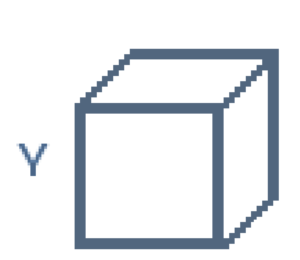 This drawing shows a cube, where Y equals the length of each side. Because it is a square, all sides are equal in length. To determine the surface area of the cube, you first have to find out the area of one side. The area of one side is Y x Y or Y2 . To find the surface area of the cube, you need to multiply the area of one side by 6. If, for example, the length of Y equalled 10 mm, then the area of one side would be 100 square mm and the area of the cube would be 600 square mm.
This drawing shows a cube, where Y equals the length of each side. Because it is a square, all sides are equal in length. To determine the surface area of the cube, you first have to find out the area of one side. The area of one side is Y x Y or Y2 . To find the surface area of the cube, you need to multiply the area of one side by 6. If, for example, the length of Y equalled 10 mm, then the area of one side would be 100 square mm and the area of the cube would be 600 square mm.
Rectangular Surface Area Formula
The surface area of a rectangle may be expressed by the formula: x = 4AB + 2AC
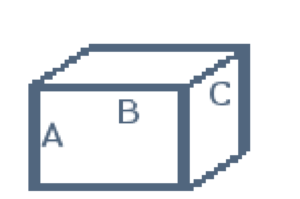 With a rectangle, all the sides are not equal…but there are three different lengths to be measured. In the drawing, these are represented by A, B, and C. To determine the area of the front of the rectangle, we’ll need to multiply A x B. Since there are four surfaces on the rectangle that are equal in size, we need 4 x A x B as one part of our formula to determine the surface area of the dimensional rectangle. We’ll also need to determine the area of the two smaller surfaces. In this case, we’ll need to multiply A x C. And, because there are two of these “faces” to the rectangle, we need 2 X A X C for the full surface area formula. If, for example, the length of A equalled 10mm, and B equalled 30mm and C equalled 15mm then:
With a rectangle, all the sides are not equal…but there are three different lengths to be measured. In the drawing, these are represented by A, B, and C. To determine the area of the front of the rectangle, we’ll need to multiply A x B. Since there are four surfaces on the rectangle that are equal in size, we need 4 x A x B as one part of our formula to determine the surface area of the dimensional rectangle. We’ll also need to determine the area of the two smaller surfaces. In this case, we’ll need to multiply A x C. And, because there are two of these “faces” to the rectangle, we need 2 X A X C for the full surface area formula. If, for example, the length of A equalled 10mm, and B equalled 30mm and C equalled 15mm then:
- A times B = 300mm, so 4AB= 1200 square mm
- A times C = 150mm, so 2AC= 300 square mm
- So the surface area of the dimensional rectangle is 1500 square mm
Why Surface Area Matters
At the nanoscale basic properties of particles may vary significantly from larger particles. This might include mechanical properties, whether the particle conducts electricity, how it reacts to temperature changes, and even how chemical reactions occur. Surface area is one of the factors that changes as particles are smaller. Because chemical reactions usually take place on the surface of a particle, if there is an increased surface area available for reactions, the reaction can be very different.
Internet Connections
Recommended Reading
- Nanotechnology For Dummies (ISBN: 978-0470891919)
- Nanotechnology: Understanding Small Systems (ISBN: 978-1138072688)
Writing Activity
Write an essay or a paragraph about how nanotechnology might impact space exploration.
Alignment to Curriculum Frameworks
Note: Lesson plans in this series are aligned to one or more of the following sets of standards:
- U.S. Science Education Standards (http://www.nap.edu/catalog.php?record_id=4962)
- U.S. Next Generation Science Standards (http://www.nextgenscience.org/)
- International Technology Education Association’s Standards for Technological Literacy (http://www.iteea.org/TAA/PDFs/xstnd.pdf)
- U.S. National Council of Teachers of Mathematics’ Principles and Standards for School Mathematics (http://www.nctm.org/standards/content.aspx?id=16909)
- U.S. Common Core State Standards for Mathematics (http://www.corestandards.org/Math)
- Computer Science Teachers Association K-12 Computer Science Standards (http://csta.acm.org/Curriculum/sub/K12Standards.html)
National Science Education Standards Grades K-4 (ages 4 – 9)
CONTENT STANDARD A: Science as Inquiry
As a result of activities, all students should develop
- Abilities necessary to do scientific inquiry
CONTENT STANDARD B: Physical Science
As a result of the activities, all students should develop an understanding of
- Properties of objects and materials
CONTENT STANDARD E: Science and Technology
As a result of activities, all students should develop
- Abilities of technological design
- Understanding about science and technology
CONTENT STANDARD F: Science in Personal and Social Perspectives
As a result of activities, all students should develop understanding of
- Types of resources
- Science and technology in local challenges
CONTENT STANDARD G: History and Nature of Science
As a result of activities, all students should develop understanding of
- Science as a human endeavor
National Science Education Standards Grades 5-8 (ages 10 – 14)
CONTENT STANDARD A: Science as Inquiry
As a result of activities, all students should develop
- Abilities necessary to do scientific inquiry
- Understandings about scientific inquiry
CONTENT STANDARD B: Physical Science
As a result of their activities, all students should develop an understanding of
- Properties and changes of properties in matter
CONTENT STANDARD E: Science and Technology
As a result of activities in grades 5-8, all students should develop
- Abilities of technological design
- Understandings about science and technology
National Science Education Standards Grades 5-8 (ages 10 – 14) (cont.)
CONTENT STANDARD F: Science in Personal and Social Perspectives
As a result of activities, all students should develop understanding of
- Risks and benefits
- Science and technology in society
Principles and Standards for School Mathematics (ages 6 – 18)
Measurement
- understand measurable attributes of objects and the units, systems, and processes of measurement.
- apply appropriate techniques, tools, and formulas to determine measurements.
Problem Solving
- build new mathematical knowledge through problem solving.
- solve problems that arise in mathematics and in other contexts.
- apply and adapt a variety of appropriate strategies to solve problems.
- monitor and reflect on the process of mathematical problem solving.
Connections
- recognize and apply mathematics in contexts outside of mathematics.
Representation
- create and use representations to organize, record, and communicate mathematical ideas.
- select, apply, and translate among mathematical representations to solve problems.
Standards for Technological Literacy – All Ages
The Nature of Technology
- Standard 1: Students will develop an understanding of the characteristics and scope of technology.
- Standard 3: Students will develop an understanding of the relationships among technologies and the connections between technology and other fields of study.
Technology and Society
- Standard 4: Students will develop an understanding of the cultural, social, economic, and political effects of technology.
- Standard 6: Students will develop an understanding of the role of society in the development and use of technology.
Design
- Standard 9: Students will develop an understanding of engineering design.
Standards for Technological Literacy – All Ages (cont.)
Abilities for a Technological World
- Standard 13: Students will develop abilities to assess the impact of products and systems.
The Designed World
- Standard 14: Students will develop an understanding of and be able to select and use medical technologies.
- Standard 19: Students will develop an understanding of and be able to select and use manufacturing technologies.
How Big is Small?
It can be hard to visualize how small things are at the nanoscale. The following exercise can help you visualize how big small can be!
The following are drawings of items you may recognize…. a bowling ball, a billiard ball, a tennis ball, a golf ball, a marble, and a pea. Think about the relative size of these items.
ADD IMAGES
Now take a look at the chart below that was developed by the National Cancer Institute (U.S.) and think about how much smaller the various items are…moving down from the familiar tennis ball. The “.” on this page is 1,000,000 microns — quite gigantic compared to a virus or a single molecule of water (H20).
Surface Area Activity
You are part of a team of engineers who has been given the challenge of evaluating how surface area changes as a material is made smaller. You have been provided with some sheets to read as well as a block of either tofu or gelatin, a cutting surface, a ruler, and a dull knife.
You will need to determine the surface area of the full block, and then the cumulative surface area of smaller blocks you create by cutting the original block in half, and quarters — down to all blocks created at about ½ inch in width.
Use the chart below to indicate your findings:
| # Blocks | 1 Block | 2 Blocks | 4 Blocks | 8 Blocks | 16 Blocks | 32 Blocks | 64 Blocks |
Surface Area: |
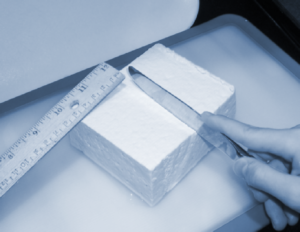
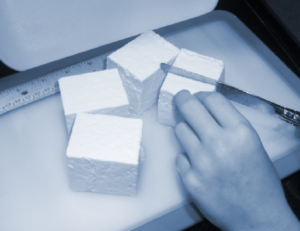

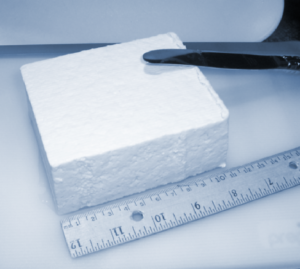
Nanoscale Applications Activity
You are part of a team of engineers who has been given the challenge to brainstorm ideas about how nanotechnology might help improve life on earth or in space. To spur your imagination, your team will first read the following press release about new research in applying silver using nanotechnology to coat surgical equipment. The innovation involves applying surface-engineered nanostructures of silver oxide onto the surface of medical devices. Silver has been found to be effective against a broad range of bacteria and also against mutating pathogens. It can also effectively block fungi and yeasts that are known to cause disease. It is also harmless to the body at its bacterial effective levels. Nanotechnology maximizes the antimicrobial ability of silver because the overall surface areas of silver-oxide it increased at the nano scale. Each tiny particle in a nanostructure has its own surface area, so the larger combined surface area means more silver can interact with body fluids to encounter and inhibit microbes.
Breakthrough Antimicrobial Technology for Medical Devices Strong industry interest in SilvaGard, a breakthrough antimicrobial nanotechnology, has resulted in significant growth for AcryMed, the company that developed and now licenses the technology. Built on years of research in developing silver antimicrobial wound treatments, SilvaGard addresses a still un-met clinical need, preventing the spread of deadly medical device-related infections. By harnessing the advantages of nanotechnology with the broad-spectrum infection-fighting ability of Ionic silver, SilvaGard provides a safe and effective solution to render medical devices impervious to infection causing biofilms.”The spread of hospital acquired infections is a significant problem that unnecessarily effect millions of U.S. patients each year and adds more than 28 billion dollars to our nation’s healthcare costs,” said Jack McMaken, president of AcryMed. “Since a large portion of harmful bacteria is harbored on medical devices such as indwelling catheters and implants, manufacturers are extremely interested in finding ways to curtail the role their products play in spreading infections. SilvaGard represents the first significant breakthrough in this area in quite some time.”SilvaGard prevents the spread of device-related infections by depositing antimicrobial silver nanoparticles onto the surfaces of medical devices and thus providing a protective barrier. Studies have shown that SilvaGard is not only safe for use, but also highly effective against a wide spectrum of infection-causing bacteria including MRSA and other antibiotic-resistant “superbugs.”In recent findings presented at the Surgical Infection Society (SIS) meeting, I-Flow’s ON-Q SilverSoaker antimicrobial catheter demonstrated a significantly lower risk of developing a surgical site infection in an on-going prospective study of patients undergoing colorectal surgery. The preliminary results captured the outcomes of 120 patients, randomized to either treatment with continuous local anesthetic using the antimicrobial treated ON-Q catheter or to the control treatment employing traditional pain relief. At 30-days post surgery, patients who received treatment with the antimicrobial ON-Q device had a significantly lower incidence of site infections at 0%, as compared to the control group at 22.9%.Source: AcryMed, Oregon, U.S. (www.acrymed.com) |
Brainstorming Stage
Meet as a team and discuss what you learned about nanotechnology and surface area. Then as a group think about a new application and how you think nanotechnology might a product, process, or anything better. You can pick an industry such as automotive, or think about a product such as fabric for clothing.
Presentation Stage
Prepare a proposal to a potential funding organization who you will request research funding. You’ll need to explain why you think your new nanotechnology application may work, and how it will improve a product or process. This is a formal presentation and you may wish to prepare charts or presentation posters — anything that might impress your potential funders. Be prepared to answer questions from your audience!
Funding
Each student in the class may vote for one proposal by any team other than their own to be funded. Those presentations with the most votes come in first place!
Evaluation Phase
Complete the following questions as a group:
- What application did you develop for nanotechnology?
- What application of nanotechnology did another team present that you found the most interesting? Why?
- What is the most interesting aspect of nanotechnology you learned during this lesson?





 Industrial Engineering
Industrial Engineering
 Computer Engineering
Computer Engineering

















